I plan to use a physically large ferrite core inductor (Murata part "1410478C", 100 µH at 1 kHz) in a 12 V, 7 A DC filter circuit. It will be mounted on topside of a four-layer PCB (from top down: top routing, split GND plane, split PWR plane, and bottom routing).
It will be filtering typical DC input from a car's 12 V system, which can be a fairly noisy environment. The circuit has transient suppression and reverse voltage protection nearby.
I am not sure what to do with the ground plane directly beneath the inductor's physical location. My instinct is to back-off the perimeter of the GND plane so that it is not close to the EM field surrounding the inductor.
There are two GND planes on layer 2, one called "VEHICLE_GND", which surrounds all the input filtering components, and another called "0V" and provides GND connections for the 3.3 V digital systems which are unrelated to the filtering. The two GND planes are connected at a single point by a through-hole zero-ohm link. Star grounding has been used throughout the design.
Is my instinct right in this instance or would it be better to allow my VEHICLE_GND plane to cover the area underneath the inductor? I would be concerned that ripple from the car's electrical system might be directed through the inductor and cause the VEHICLE_GND plane to exhibit the same ripple probably at a slightly lower amplitude.
Any guidance would be welcome.
- Inductor datasheet: http://www.farnell.com/datasheets/1697186.pdf
EDIT...
I have accepted Oliver Street's excellent answer and have decided to remove the GND plane beneath the inductor (also suggested by Peter Smith) as it does not form a hole in the plane in my case due to the inductor being crammed into the corner of the PCB. However had the removal caused an enclosed hole to form (and quite a large one) I would be less inclined to perform the removal. The PCB has not yet been manufactured, and I still have an opportunity to perform some measurements on my selected components, now that I have some idea what to look out for.
Here's a rough sketch of the position of the GND plane and the inductor for the curious.
